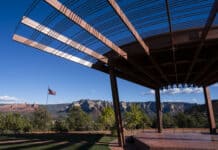As most residents remember from last year, a pair of wildfires above the Mogollon Rim northwest of Sedona burned for more than two months.
The Platypus and Rhino fires — the names were alphabetical markers of small, lightning-caused wildfires that all struck during a few days of electrical storms — consumed the tops of Secret Mountain and Little Round Mountain. The two fires burned slowly, barely spreading due to the relatively wet terrain caused by the summer monsoon.
Due to the rugged terrain, firefighters weren’t able to battle these fires in the same way they tackled the 21,227-acre Slide Fire or 4,317-acre Brins Fire in Oak Creek Canyon in 2014 and 2006, respectively.
On Aug. 2 of this year, another lightning-caused fire struck the location of last year’s Platypus and Rhino fires. Nearly two weeks later, the Saber Fire has only spread to about 95 acres. This is a drastic contrast to the Museum Fire last month that started north of Flagstaff and spread to 500 acres in four hours and more than 1,000 acres in a day.
Like the Platypus and Rhino fires, the Saber Fire is hampered by healthy, wet terrain caused by recent monsoon downpours. It also doesn’t have much fuel to burn as it’s basically atop the burn scar from the 2009 Taylor Fire, meaning it is mainly burning 10-year-old undergrowth, bushes and young trees, not 50- to 100- year-old ponderosa pine trees and conifers that could greatly speed up fire spread.
The Museum Fire is still smouldering but has been completely contained at 1,961 acres. The swiftness of that blaze, combined with its proximity to populated neighborhoods, led to evacuations and pending evacuations along the northern edge of Flagstaff and the western side of East Flagstaff, which wraps around Mount Elden and the San Francisco Peaks.
Fortunately, the Saber Fire is burning on uninhabited land more than a dozen miles from Sedona and miles away from any homes, atop a hard-to-access ridge. Until the next monsoon storm rolls through, we can expect some smoke to drift into Sedona and the Verde Valley, depending on wind and weather conditions.
Those leaving Sedona for Cottonwood yesterday may also have noticed a major plume of smoke far to the west. This is the 965-acre Pemberton Fire, burning not on Mingus Mountain as it appears from our vantage point, but burning short grasses on the slopes of the Bradshaw Mountains east of Chino Valley, and directly north of Rancho Diamonte, an unbuilt community that currently consists of a few dirt roads and no buildings. Smoke from this fire likely won’t impact the Verde Valley.
As we reported earlier this month, the Arizona monsoon has been slow to start. The strong El Niño over the Pacific has reduced the inflow of moist air from the Sea of Cortez that works its way north to the Verde Valley after falling on Phoenix and the Sonoran Desert. El Niño should weaken in late August and September, meaning we will have a late, light monsoon, which may extinguish the Saber and Pemberton fires if they don’t go out on their own before then. In the meantime, avoid breathing smoke if you can help it. People most at risk are those with heart or lung diseases, children and older adults.
Use common sense. If it looks smoky outside, it is probably not a good time for outdoor activities. Generally, the worse the visibility is, the worse the smoke particulates are. Do not let children play outdoors in the morning or when the smoke settles later in the evening. If you feel ill as a result of smoke, stay indoors, use a High Efficiency Particulate Air filter and limit outdoor activities. Pay attention to local air quality reports. Stay alert to any news coverage or health warnings related to smoke.
Keep your windows and doors closed. Make sure air conditioning units have a clean filter in the air intakes. Don’t use anything indoors that burns, such as wood fireplaces, gas logs, gas stoves or even candles. If you can help it, don’t vacuum as that stirs up particles already inside your home. Don’t smoke indoors.
Despite claims, common paper or cloth face masks will not protect your lungs from small particles in smoke.
Christopher Fox Graham
